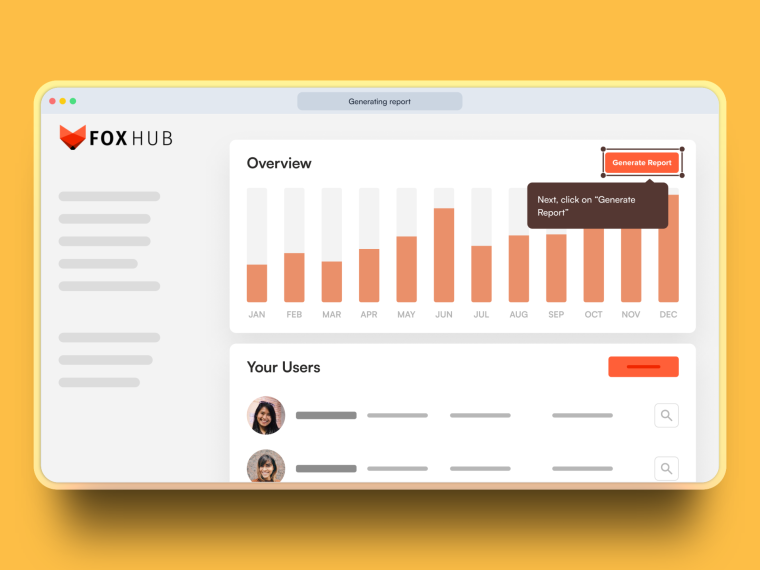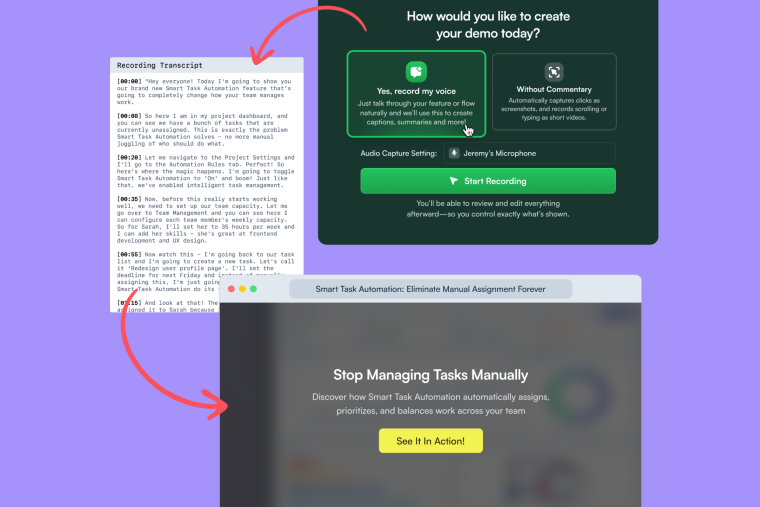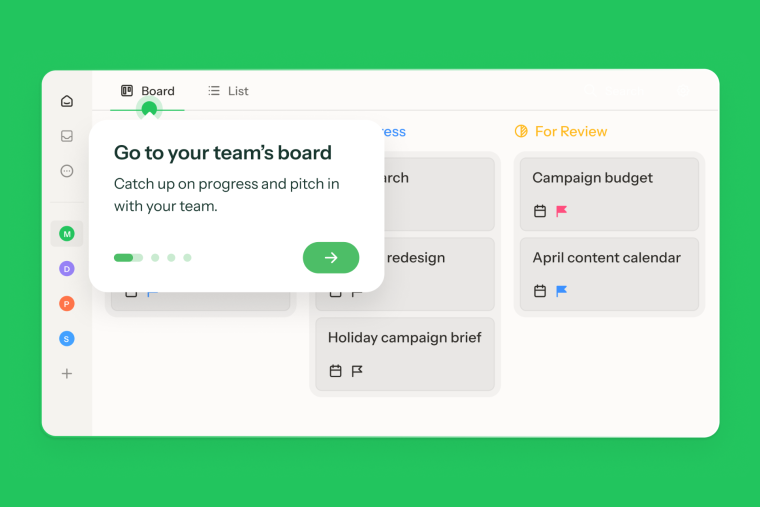Imagine you’re at a car dealership. You wouldn’t buy a car without taking it for a spin, right? That’s essentially what a product demo is—a test drive for your software. It’s a way to showcase your product in action, giving prospects a sneak peek of the value it can bring to their business. Demos help prospects understand how your product works and why they need it.
Demos are decision accelerators, helping users visualize success before they even commit.
Interactive demos drive conversion and activation by removing friction, allowing prospects to explore at their own pace and hit critical milestones faster.
Tailoring demos to your growth strategy is key—whether PLG or sales-led, the right demo can turn curiosity into confidence, and confidence into action.
What is a product demo?
A product demo is a show-and-tell for your product, where you walk potential customers through its features and benefits. In the SaaS world, demos help people see how the software works and how it can solve their problems.
There are a few types of demos you might come across:
- 1 Live demos: A real-time walkthrough where someone (usually from the Sales team) shows off software and answers questions on the spot.
- 2 Interactive demos: These let users experience the product hands-on in a guided or sandbox environment and explore how it works themselves. Incorporating marketing materials like demo videos can enhance user engagement and conversion rates.
- 3 Video demos: Pre-recorded presentations that potential customers can watch at their own pace, more often used in marketing. A well-crafted demo video can effectively showcase product features and benefits, build trust, engage the audience, and drive conversions by addressing specific pain points and highlighting how the product meets users' needs.
Demos are key to helping prospects get a feel for the product and decide if it’s a fit. Whether live, interactive, or video, they give customers the information they need to make a decision.
Definition and purpose of product demos
A product demo is more than just a presentation—it's a powerful tool that showcases the value, benefits, and uses of your product or software to a prospective customer. Think of it as a guided tour that highlights how your product can solve specific problems and meet the needs of your audience.
The primary purpose of a product demo is to educate users about the product's features and benefits, positioning it as an effective solution tailored to their unique challenges. Whether you're adopting a sales-led or product-led growth approach, product demos are instrumental in driving sales, generating leads, and closing deals.
How do product demos differ from the sales process?
While the terms are often used interchangeably, a product demo focuses on showing what the product does, whereas a sales demo leans more into the why—why your solution is the perfect fit for the prospect’s specific pain points. Product demos tend to be more educational, walking users through key features and capabilities, while sales demos are more personalized, and tailored to a prospect’s specific needs and goals.
Why are product demos essential in the customer journey?
Let’s be real—buyers are savvy. They don’t want a pitch; they want proof. A product demo video gives them that, building customer confidence by showcasing the product's value proposition in an engaging and easy-to-understand manner.
Whether it's a live session, an interactive tool, or a pre-recorded video, demos give customers confidence in your product. It's the moment when they can visualize how your solution will solve their problems. A well-executed product demonstration can significantly influence buying decisions by effectively conveying the features and benefits of the product. A great demo can cut through the noise, increase engagement, and ultimately shorten the sales cycle.
The role of product demos in the sales process
Product demos are a pivotal part of the sales process, typically coming into play after a lead has been qualified. Delivered by a skilled sales rep or account executive, these demos are designed to present the product’s features, functionalities, and benefits in a way that resonates with the prospective customer.
The goal is to build trust, establish relationships, and demonstrate solutions that address the prospect’s specific pain points. By doing so, product demos help to drive purchase decisions, making them an essential tool in any sales rep’s arsenal.
Why product demos matter
In the sales process, product demos are indispensable. They provide a clear and tangible understanding of the product’s value proposition, helping to alleviate any concerns or doubts about its effectiveness or reliability.
By showcasing the product’s features and benefits in a compelling way, a well-executed demo can significantly improve close rates. It boosts confidence in the product and provides prospective customers with a clear understanding of how it can solve their problems and enhance their workflows.
What are the different types of product demos?
Not all demos are created equal, and each type serves a different purpose in your sales funnel. Let’s break down the three major types:
One-on-one demos
These are your classic sales demos, where a rep walks a prospect through the product live. They're ideal for complex, high-touch sales processes where the product needs to be tailored to individual use cases. Think of this as a white-glove service—very personal but not scalable.
Video demos
Want to scale your demo process? Pre-recorded product demo videos allow you to engage potential customers and significantly improve conversion rates by showcasing your product's key features and benefits. They’re great for top-of-funnel prospects who need a high-level overview of your product without a heavy time commitment. Short, sweet, and easily digestible.
Interactive demos
Interactive demos are the rising stars. They let prospects play around with your product in a hands-on way, mimicking the in-app experience without needing to create an account or commit. These demos are great for product-led growth (PLG) strategies, allowing users to explore features at their own pace.
Which type of product demo should you use?
Choosing the right type of demo depends on your growth strategy, onboarding style, and the complexity of your product. Incorporating interactive demos and videos into your sales and marketing materials can significantly boost conversion rates and effectively showcase your product's value. You can decide which one is right for you based on three factors:
Your growth strategy (Product-led vs Sales-led)
If you're a PLG pro, interactive demos are your bread and butter. They let users get comfortable with your product early on, helping them reach their “aha” moment faster. For sales-led companies, one-on-one demos might be a better fit, particularly for high-ticket items that require more personal engagement.
Your style of onboarding
Does your product need a hands-on walkthrough, or can users get value with minimal guidance? If it’s the former, one-on-one demos or interactive experiences are the way to go. For self-service products, video demos work wonders.
The complexity of your product
The more complex the product, the more likely you’ll need a one-on-one demo to explain it fully. However, even complex products can benefit from interactive or video demos that simplify the experience.
What are the benefits of using interactive product demos?
Interactive demos let users control their buying and evaluation experience, offering a more engaging and personalized way to explore your software. Here’s why they’re great:
- 1 Scalability: You can’t be everywhere at once, but your demos can be. Interactive demos allow prospects to engage with your product 24/7.
- 2 Engagement: Interactive demos pull users into the driver’s seat, keeping them engaged for longer.
- 3 Data-Driven: They also provide valuable analytics—track how users interact with your demo, see what features catch their attention, and where they drop off.
- 4 Faster Decision-Making: Prospects experience the product’s value firsthand, speeding up their decision to convert.

The DAP Buyer's Guide
Avoid a DAP-saster. Learn how to buy software you’ll love.
How do product demos influence buying decisions?
Interactive product demos influence buying decisions by giving prospects a firsthand look at your product—without the pressure of a sales pitch. Video demonstrations are crucial in showcasing real-world use cases, allowing users to explore the product at their own pace, test out features relevant to their needs, and reach that critical “aha” moment on their own terms.
Effective product demos can clearly illustrate the product's features and address customer needs, ultimately leading to informed purchasing decisions. This creates a more relaxed, user-driven experience where the prospect feels in control. The better they understand the product’s value and how it fits into their workflows, the more confident they become in making a purchase decision.
Interactive product demos also remove friction from the decision-making process. Instead of waiting for a scheduled demo or asking questions through back-and-forth emails, prospects can immediately explore the product, understand its benefits, and make a decision faster—on their own timeline.
How do product demos improve free to paid conversions?
Product demos don’t just show off your product—they’re your secret weapon for conversions. By letting prospects take the wheel, you remove uncertainty and highlight how your product solves their problems. It’s like handing them the keys to their next must-have solution. A great interactive demo doesn’t just tell them what your product can do—it shows them why they need it.

The impact of interactive demos on free to paid conversion
In fact, we ran an experiment to see how interactive demos stack up. Users who tried an interactive demo were almost twice as likely to convert—3.4% versus 1.6%. Turns out, when prospects can see your product in action without waiting for a sales pitch, they’re more likely to buckle up and hit that “buy” button.
How do product demos influence user activation?
Demos aren’t just for show—they get users activated faster than you can say “onboarded.” A great demo pulls users right into the experience, cutting through any sign-up friction and letting them dive straight into the action. The sooner they can explore, the quicker they reach that all-important first milestone.
We put this to the test by swapping our gated onboarding flow for interactive demos, and the results were impressive. Activation rates jumped from 41.2% to 50.85%—and even better, 13.6% of users who played around with the demo went on to publish their first experience, compared to just 4.6% before. Turns out, letting users test-drive your product early on gets them hooked faster.

The impact of interactive demos on user activation
Best practices for product demos
- 1 Prevent overloading your audience: Don’t try to show off every feature all at once. Focus on the most impactful aspects that align with your audience’s pain points.
- 2 Address pain points: Personalize your demo to address your prospect’s specific challenges. Show them how your product solves their exact problems.
- 3 Keep your audience engaged throughout: Keep it engaging whether it’s an interactive demo or a live walkthrough. Ask questions, create moments of interaction, and, most importantly, make it fun!
How to build an effective product demo
Building an effective interactive product demo is about more than just showing off features. You have to create an experience that resonates with your audience, solves their pain points, and leaves a lasting impression. Whether you're creating a demo for sales teams to use in one-on-one calls or an interactive experience for prospects to explore on their own, the key to success lies in structure, personalization, and storytelling.

"A great interactive demo isn’t just about features—it’s about crafting an experience. You want prospects to see themselves using the product, solving their problems, and hitting their goals. The magic happens when they start picturing your product as their solution."
So, how do you create that magic? Let’s break down the components of a strong demo.
Key features of a good product demo
Creating a good product demo involves more than just a simple walkthrough. Here are the key features that make a demo effective:
- 1 Clarity: Clearly communicate the product’s purpose and value proposition. Your audience should immediately understand what your product does and why it matters.
- 2 Engaging Visuals: Use visual elements such as graphics, animations, and videos to make the demo more engaging and memorable. Visuals help to capture attention and illustrate complex concepts.
- 3 Demonstration of Key Features: Highlight the most important features and functionalities of the product. Focus on what sets your product apart and how it addresses the specific needs of your target audience.
- 4 Real-World Use Cases: Provide real-world examples or scenarios in which the product can be used. This helps prospects visualize how the product can fit into their workflows and solve their problems.
- 5 Interactivity: Allow the audience to actively engage with the product during the demo. Interactive elements can make the experience more immersive and memorable.
- 6 Clear Call to Action: Conclude the demo with a clear call to action, prompting the audience to take the next step, whether it’s signing up for a trial, scheduling a follow-up call, or making a purchase.
By incorporating these key features, businesses can create product demos that not only educate but also engage their target audience, ultimately driving sales and growth.
What are the components of a strong demo?
- Clear Structure: Every effective demo starts with a high-level overview. Set the stage by giving your audience a sense of what your product does and the problems it solves. Once they’re oriented, dive into specific features and use cases that are most relevant to them. End with a strong call to action that guides them on the next steps.
- Customization: One-size-fits-all demos are a thing of the past. Tailor each demo to the specific needs of your audience. Whether it’s addressing pain points, highlighting key features that match their use case, or personalizing the flow, customization is what turns a good demo into a great one.
- Storytelling: Facts tell, but stories sell. Instead of just listing out features, show your product in action through real-world examples or case studies. Paint a picture of how your product can transform their workflows, solve their challenges, and help them achieve their goals. By framing your demo as a narrative, you engage prospects on a deeper level and make your product feel like a solution they can’t live without.
10 Examples of great interactive product demos
15Five’s Interactive Product Tour
15Five’s demo is an excellent example of a self-serve, on-demand walkthrough that lets users explore at their own pace. It’s a prime choice for busy professionals who want a quick yet informative platform overview without scheduling time with a sales rep.
Feedbucket’s Interactive Product Tour
Feedbucket’s interactive demo is front and center on its homepage, providing immediate access for users to see how effortlessly they can capture feedback. Its simplicity and user-focused design make it easy for prospects to understand the tool's value right from the first interaction.
Gong’s Interactive Product Tour
Gong’s demo provides a clear, no-frills approach to showcasing its revenue intelligence platform. The demo keeps things simple yet powerful, focusing on its core capabilities with real-life use cases that show immediate value to sales teams.
Labelbox’s Interactive Product Tour
Labelbox’s demo is immersive, providing a hands-on experience where users can interact with its machine-learning platform. The tour guides users through real-world applications, allowing them to see how the product can enhance their workflow.
Lokalise’s Interactive Product Tour
Lokalise’s product demo excels in its simplicity and usability, offering a straightforward walkthrough that highlights key features. Its well-organized flow makes it easy for users to understand how the product fits their localization needs.
Onedata’s Interactive Product Tour
Onedata’s interactive tour focuses on the ease of use and value it provides to data teams. The demo is informative but not overwhelming, giving a clear sense of how the product works in a real-world scenario while keeping engagement high.
Segment’s Interactive Product Tour
Segment’s product demo is a stellar example of how to blend education with interactivity. It not only walks users through key features but also ties in case studies and real-world applications, making it more engaging and persuasive.
Slack’s Interactive Product Tour
Slack’s demo puts the user in control, offering a sleek, interactive experience that mirrors how the platform functions in real life. It’s intuitive, allowing users to grasp the value of Slack through direct interaction with the product's core features.
Unbounce’s Interactive Product Tour
Unbounce’s interactive demo shines by offering a hands-on experience that replicates the ease of creating landing pages. Its focus on simplicity and quick engagement allows users to see value fast, making it a great tool for lead conversion.
Vitally’s Interactive Product Tour
Vitally’s demo highlights its platform in a structured, easy-to-follow manner, walking users through the analytics and customer success features step by step. It’s ideal for those who want to quickly understand how Vitally can drive customer outcomes without requiring a live session.
Future trends in product demos
As technology evolves, so do product demos, with new trends shaping how companies showcase their products and engage prospects.
How is AI changing product demos?
AI is transforming demos by making them smarter. Expect demos to get more interactive, with AI-driven features that personalize the experience based on a user’s engagement. AI can also help analyze demo performance, offering insights to optimize future demos.
Why is personalization the future of demos?
Personalization is no longer a nice-to-have—it’s a must. Tailoring demos to individual prospects boosts engagement and ensures that each user gets a relevant experience. Think Netflix recommendations, but for software demos.
Mastering product demos is essential for any SaaS company looking to scale. You can build trust, answer prospects’ questions, and drive conversions by showcasing your product's value through interactive, engaging demos. Whether you’re using one-on-one demos, video walkthroughs, or the latest interactive platforms, the key is to focus on the user experience and make sure your demo leaves a lasting impression.
Ready to get started? Check out Chameleon’s interactive demo hub for inspiration, or sign up for a free account to get started with Interactive Demos that drive product adoption.






